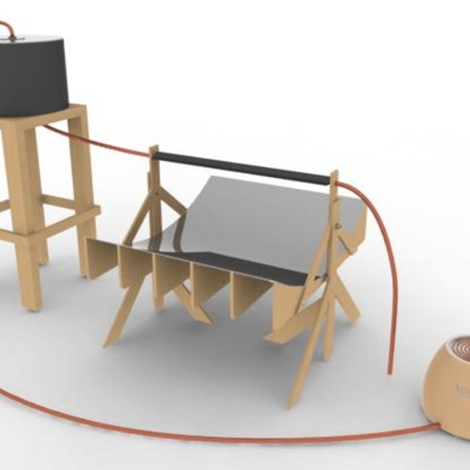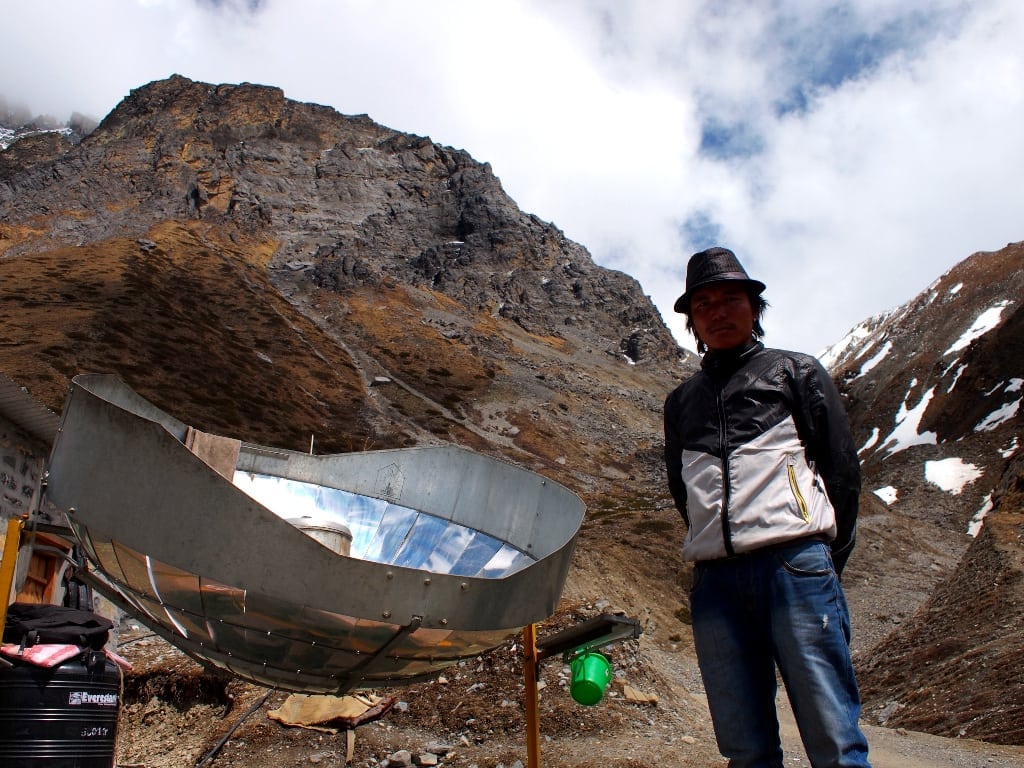
This is the first step in cooking a meal in many rural Indian villages. See the beautiful images from rural India at our Flickr photostream. Photo by Karan Singh Rathore / www.sanjhi.org
The solar cooker is finally getting a practical overhaul. With few exceptions, solar cooking has been a disaster that happens again and again to well-meaning people in developed countries. It is such a clean, shiny idea that feels like the future until you actually build it. Then its flaws jump out.
It only works for a few hours in the middle of a sunny day, but not at night or in the mornings when people actually want to cook. If it worked better, it could replace open fires and solve dire deforestation and indoor air pollution problems in developing countries.
Challenge accepted
Working better means working at night. Climate Healers, an international development technology organization, issued a design challenge last year after their traditional solar cookers failed to catch on in mountain villages in Rajasthan, India (see our coverage in Challenge: Make a solar cookstove that works at night).
H. S. Udaykumar, a mechanical engineering professor at the University of Iowa, explains the challenge like this: “First, the cooker should operate in the early morning and late evening when the sun is not at peak. They should be able to cook indoors, sitting down. They cook for two hours each time. The stove top temperature should be about 200C, with heat delivered at approximately 1 KW to the cook surface.”
Three US university teams, including the University of Iowa, accepted the challenge in early 2011. Their designs are below. Later that year, dozens of Indian university teams entered their proposals into the Shaastra Social Innovation Challenge at the Indian Institute of Technology, Madras. These are ten takes on an energy-storing solar stove.

The iHawk Cooker prototype. Photo courtesy of H. S. Udaykumar
The iHawk Cooker
University of Iowa, Iowa City, Iowa
In January, Udaykumar led a group of his undergraduate students in the development of their iHawk Cooker in villages in Rajasthan. The students were building on a design that another Iowa student team had made in the spring of 2011, then called the Hawkeye Cooker.
[See a set of beautiful images of Rajasthani villages by two photographers who accompanied the students]
The Iowa team is withholding its design updates for now pending improvements, but we have an in-depth report on the 2011 prototype. Here’s how it works.
The cooker concentrates solar energy with a half-pipe parabolic reflector, directing the sunlight onto a second V-shaped mirror in the center, which reflects through a glass panel onto an absorber plate. The absorber is inside the stove’s storage unit, which is a plywood box filled with sand and aluminum cans arrayed to boost thermal conduction. The sand and can array are insulated with a surrounding layer of rice husks. The storage unit delivers heat to the cooking element inside the cook’s nearby home. The cooker has two separate storage units, one for morning and one for evening cooking.
See the paper (pdf)
Heat delivery system
University of California, Berkeley
In collaboration with the students, a separate team from the University of California, Berkeley, designed a heat delivery system for the iHawk Cooker. The team considered and tested several methods, thoughtfully documenting each idea. They settled on system with three-fluids and two heat exchangers. During the day, the system transfers the heat collected in a tube in the reflector’s trough to the storage unit. At night, it transfers heat from the storage unit to the stove. Their report explains the concept in detail.
The Berkeley team also had an interesting idea for how to introduce the solar cookers to a community that has already rejected the simpler Namaste day-time solar cookers. They propose that Climate Healers deliver a fuel-efficient wood-burning stove to the community and, in a side-by-side demonstration, prove its superiority to the open fires in common use now. Once they have established the fact that new stove technology makes life easier, the Climate Healers team can deliver solar cookers, trading them for fuel-efficient stoves.
See the paper (pdf)
PETE induction cookstove
Deepti Nayak
Putting a relatively new technology to work, this stove heats an induction coil with a sun-charged battery. The novelty is how the device converts solar energy to electricity. It uses a technology called photon-enhanced thermionic emission, developed by Stanford researchers who wrote about it in a paper published online in Nature in August 2010. PETE captures and converts both heat and light, rather than just one or the other, to boost efficiency.
See the paper (pdf)

CARES stove
Gopal Roy, Simran Jena, Abhishek Bisoi, Sanit Kumar
The elements combine in this interesting design: Metal, sand, water and – not an element, but still a basic material – coconut husks and straw (bonus points for repurposing local agricultural waste). Reflectors focus solar energy on a metal plate that heats and can cook by day, and it also disperses heat to a water-filled tube. The tube coils through and heats up sand or salt inside a ceramic container insulated with the husks and straw. At night, the energy stored in the sand or salt throughout the day can heat the metal plate for cooking.
See the paper (pdf)

Scheffler cooker
Nitin Mohurle
This team provides well- researched guidelines for building a hybrid solar and fuel-burning oven. The solar component is based on a Scheffler cooker, a large parabolic reflector that is easily positioned to concentrate sunlight through a space in the kitchen wall onto the cooker. The cooker is well insulated with ceramic, sand or salt and stores the reflected heat throughout the day for use at night. On cloudy days and nights when it is needed more than usual, the stove can also burn wood or some other fuel efficiently.
See the paper (pdf)
Solar box cooker
Sreendhi Institute of Engineering and Technology, Hyderabad
This spin on the traditional solar box cooker adds heat-storing salts – sodium and potassium nitrates – to a heavy-duty double box construction. There is an outer box with a glass lid and an inner box surrounded by insulating glass wool. Two reflectors direct sunlight through the glass lid and heat the salt, which melts and stores heat for later use.
See the paper (pdf)

This detail on the central part of the stove shows where the operator pours water when cooking at night.
Parabolic cooker with steam
Gitam University, Rushikonda, Vizag
This cooker design starts with a repurposed umbrella: the umbrella tines frame an aluminum-foil parabolic reflector. A dark-colored device above the reflector absorbs the solar radiation and stores it in a double-walled chamber. The outer part of the chamber is filled with salt as an insulator and heat collector, and the inner part is filled with oil. At night, the cook pours water into a spout on the side of the device, the water trickles through channels surrounded by the hot oil, converts to steam and rises to heat a hotplate for cooking.
See the paper (pdf)
Box cooker with steam
Team Anshuk, MGR University in Chennai
In this well-documented design, two aluminum boxes are nested in bricks inside a wooden box. The box has a double-paned glass lid that allows sunlight to heat the inner boxes and the insulating bricks. For night cooking, water passes through the system, becomes steam and enters the kitchen through PVC pipes. The emphasis is on low-cost materials and durability.
See the paper (pdf)
 Molten-salt solar cooker
Molten-salt solar cooker
Silicon Institute of Technology, Bhubaneswar
Another well-documented design, the molten-salt cooker concentrates solar radiation onto a black-colored water tank using a Scheffler reflector. The water heats, converts to steam and passes through a heat exchanger to the solar cooker. The water tank is inside a brick tower surrounded by reflectors. The device stores excess heat in an insulated chamber filled with salt and can continue to heat water for steam cooking at night. The design has potential for both grills and ovens.
See the paper (pdf)

Solar cooker with oil
Georgia Institute of Technology
Georgia Tech students This design heats oil in a solar reflector and stores it for later use. Using a hand or foot pump, the cook draws the oil from the storage container to a heat-exchanger that serves as the cooking element. The cold oil is stored in a raised container and trickles down through the reflector. The operator can control the amount of oil that passes through the system, changing it according to the weather. This is a highly detailed report that critiques other efforts to create an energy-storing stove and includes data on the constellation of environmental and social problems around cooking on wood fires in rural kitchens.
See the paper (pdf)


Hi, all links on this page is not accessible. can you please share pdfs if you have them?
Really wish to be part of a movement that’s aimed at helping earth, by reducing dependence on its rapidly dwindling resources..
There is a solar cooker that works in the morning, throughout the day, and all the way until sunset. Please take a look and understand the features of the All season solar cooker. Low tech. amazing. simple
Plot no 85, Room no 862
Sector 22, Turbhe,Navi Mumbai.
this is awesome thanks for the facts I am building my own at school for a project;):):););):):);):):);):):);):):);):):);):):);):):);):):);):):);):):);):):);):):);):):);):):);):):);):):);):):);):):);):):);):):);):):):):);):):)
Iraq, Basra, Hamdan Industrial area
Ashar, P.o.B 475
Patent has been granted for the Greenhouse Solar Cooker (NG/P/2016/426…see attached diagram) by the Nigeria Patent Office….This solar cooker comprises mainly of a parabolic borosilicate glass boiwl that is similar to the Alorno Borosilicate glass bowl (https://www.amazon.in/Alorno-Borosilicate-Glass-Mixing-Bowl/dp/B00KDHCKXK).
We’re now searching for collaborators to manufacture/market two basic designs of this invention namely: 1. simple greenhouse solar cooker embodiment (solar water pasteurizer) which comprises a parabolic transparent glass bowl with half of its inner surface covered by reflective material on which an equally transparent glass cover-lid can efficiently serve as a solar-water pasteurizer cum distiller for water or any suitable colorless liquid. 2. more complex but efficient greenhouse solar cooker as depicted in the attached diagram where a sealed parabolic glass bowl containing greenhouse gas mixture focus sunlight on a cooking pot that is placed within a central indentation. Note that the lower part of the central indentation has a metal (copper) plate embedded in a glass to metal coupling) which serves as the heat sink to transfer trapped heat onto the cooking pot. This second design can be made without an inner reflector wherein it relies on reflector for any single or multiple solar external reflector from other types of solar cooker.
Kindly provide me with links to institutions/firms or individuals who could collaborate with me to manufacture/market four possible greenhouse solar cooker invention.
More information about the invention can be read via this web-link http://solarcooking.wikia.com/wiki/Greenhouse_Solar_Cooker (the photo attached here is that of an experimental model).
Thank you for your anticipated attention.
Yours sincerely,
fantastic
HI I am keshav jha.i want to do manufacturing of solar chulha or stove under prime minister employment generation programme.i need business partner which is a able in solar energy field.please contact me 9934777115
who ever said that solar cooking in developing countries was a disaster is grossly misinformed. There are many thousands of solar cookers successfully utilized in every day life.